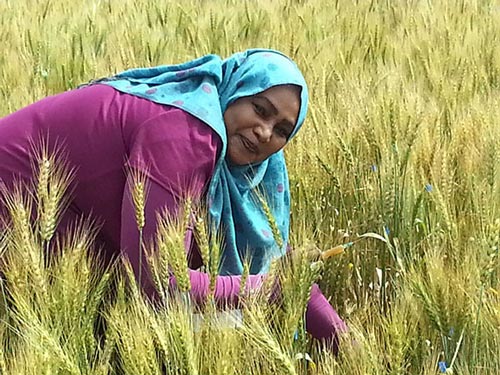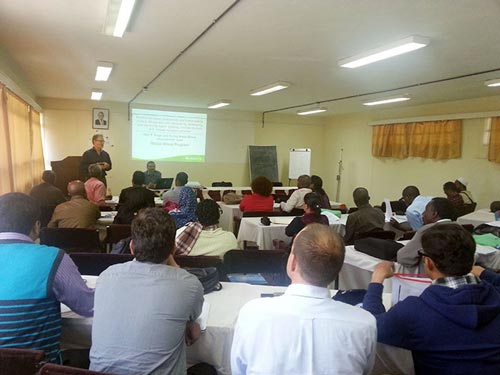
For the fifth consecutive year, scientists from around the world met at the Kenya Agricultural Research Institute (KARI) facility in Njoro for training on “Standardization of Stem Rust Note-taking and Evaluation of Germplasm.” The course, conducted 22 September to 2 October, attracted 30 scientists from 15 countries (Bangladesh, Bhutan, Egypt, Ethiopia, India, Kenya, Mexico, Nepal, Pakistan, Rwanda, Sudan, Uganda, United States, Yemen and Zambia). The course created increased awareness about the threat of rusts (especially Ug99) on wheat production. The wheat research scientists were trained on new approaches in fighting the rust diseases (including genetics, pathology, breeding and molecular genetics) and taught common approaches in identifying, scoring and evaluating rust diseases both in the field and in experimental plots.
Practical demonstrations focused on rust methodologies and handson experience in recording disease scales both in the greenhouse and field, according to Sridhar Bhavani, CIMMYT wheat pathologist/ breeder and course coordinator. Participants had the opportunity to work with the East African component of the Borlaug Global Rust Initiative (BGRI) and Durable Rust Resistance in Wheat (DRRW) projects in Kenya. These are designed to monitor further migration of Ug99 and its variants; facilitate field screening of international germplasm; identify new sources of resistance; understand the genetic basis of resistance; develop durable, targeted breeding programs; and enhance the capacity of national programs. Participants had the opportunity to interact with international scientists, and trainers learned of emerging problems from the participants.
Attendees also visited the KARI breeding program and farmers’ fields to inspect the new varieties. Members of CIMMYT’s Board of Trustees and Management Committee as well as KARI dignitaries also visited the screening site at KARI Njoro on 26 September and interacted with Oliver Nightingale from Menangai Farms, a progressive farmer who demonstrated one of the new varieties (“Kenya Robin”) which was planted on 1,000 acres of his farm near Njoro. “Wheat farmers in Kenya have benefited greatly with the new varieties developed by CIMMYT and released by KARI. These varieties are not only resistant to rust but generate yields 10 to 15 percent higher than the local varieties and are resistant to stem rust,” Nightingale told the group. Two varieties – “Kenya Robin” and “Kenya Eagle” – are CIMMYT introductions which have become very popular with farmers and currently occupy 25 to 30 percent of the wheat area in Kenya. “Kenya Robin has bold grains, good straw strength, still stands after three hail storms and yields between 6.8-7 tons per acre, whereas the older variety ‘Kwale’ lodged flat in farmers’ fields in similar conditions,” added Nightingale.

He thanked CIMMYT and KARI for introducing high-yielding varieties in Kenya. The 2013 main season screening nursery has more than 25,000 wheat accessions from 15 countries and research institutions to be evaluated for resistance to Ug99 and close to 50,000 accessions are tested every year. According to Bhavani, more than 300,000 lines have been tested at KARI-Njoro since 2006 and eight varieties have been released since 2008 in Kenya and more than 40 Ug99-resistant varieties/advanced lines have been released globally. “Every year as a part of CIMMYT-Kenya shuttle breeding nearly 1,000 F3 and F4 populations are selected under high disease pressure for two generations at KARI-Njoro and several high-yielding lines with good levels of Ug99 resistance have been identified,” added Ravi Singh, CIMMYT distinguished scientist.
The KARI-CIMMYT screening nursery has produced global benefits that go beyond Kenya’s borders – with spillover effects reaching neighboring countries including Ethiopia, Tanzania, Uganda and Zambia. “Commitment to the cause through global partnership, free exchange of germplasm, scientific expertise and donor funding have been the key features leading to the success of this project,” said Hans Braun, director of CIMMYT’s Global Wheat Program. He continued, stating, “CIMMYT Board members were impressed with the progress in the fight against Ug99, the logistics that go into operating this global rust screening platform in Njoro and the impact that has been achieved through release and adoption by farmers of rust-resistant varieties around the globe.” The annual course is part of the wider BGRI/DRRW project in Kenya, an initiative of Cornell University that is being implemented by CIMMYT and KARI in collaboration with 16 other research institutions worldwide. The project is funded by the Bill & Melinda Gates Foundation and the UK Department for International Development. To date, more than 100 pathologists, breeders and geneticists have been trained at KARI-Njoro. Scientists from Australia, Kenya, the United States and CIMMYT lectured on several aspects of wheat rust research. As Zambian participant Lutangu Makweti said: “It time for us to utilize the knowledge gained in the training course and implement better surveys and breeding activities in our countries.” Participants thanked CIMMYT and KARI for the opportunity to learn about rusts, the practical, handson training and the opportunity to interact with the global rust community. The long-term partnership between CIMMYT and KARI is achieving numerous milestones in the fight against the Ug99 race group and producing outcomes that benefit the entire global wheat community. For more information contact Dr. Sridhar Bhavani, wheat breeder/ coordinator DRRW-screening for stem rust in East Africa, CIMMYT-Kenya at S.Bhavani@cgiar.org.
 Capacity development
Capacity development